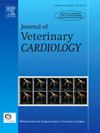Short- and long-term effects of hydrochlorothiazide in dogs with relapsing congestive heart failure due to myxomatous mitral valve disease: a retrospective analysis of 38 cases
IF 1.3
2区 农林科学
Q2 VETERINARY SCIENCES
引用次数: 0
Abstract
Introduction/Objectives
Information on the use of hydrochlorothiazide (HCTZ) in dogs with relapsing congestive heart failure (CHF) due to myxomatous mitral valve disease (MMVD) is limited. Therefore, the aim of this study was to provide data on HCTZ's short- and long-term effects in canine MMVD.
Animals, materials, and methods
Signalment, clinical, diagnostic, therapeutic, and outcome data of dogs with relapsing CHF due to MMVD treated with HCTZ were retrospectively reviewed. The initial time point was the day HCTZ was introduced for a CHF relapse. Optimized criteria were used to determine the appropriate timings for evaluating HCTZ's short-term effects on laboratory and echocardiographic variables and its long-term impact on CHF management.
Results
Thirty-eight dogs were included. The initial median dose of HCTZ was 0.8 mg/kg/die. At a median of seven days after HCTZ prescription, creatinine, urea, and total calcium levels significantly increased, while sodium and potassium levels significantly decreased (P: from 0.045 to <0.0001). While no dog developed severe electrolyte abnormalities, some dogs showed severe increases in creatinine and urea. After a median of 95 days, no significant echocardiographic changes developed (P: from 0.74 to 0.13). Episodes of CHF were more frequent before (median: one every 68 days) than after (median: one every 124 days) HCTZ prescription (P=0.006).
Study limitations
The study limitations included the retrospective design of the study; not all dogs were included both in the short- and long-term analysis.
Conclusions
In canine MMVD, HCTZ is useful in long-term management of relapsing CHF. However, in the short term, HCTZ can cause laboratory abnormalities, primarily increased creatinine and urea.
氢氯噻嗪对二尖瓣黏液瘤性疾病所致复发性充血性心力衰竭犬的短期和长期影响:38例回顾性分析
介绍/目的氢氯噻嗪(HCTZ)在二尖瓣黏液瘤病(MMVD)所致复发性充血性心力衰竭(CHF)犬中的应用信息有限。因此,本研究的目的是提供HCTZ对犬MMVD的短期和长期影响的数据。动物、材料和方法回顾性回顾了经HCTZ治疗的MMVD所致CHF复发犬的信号、临床、诊断、治疗和结局数据。初始时间点为CHF复发时引入HCTZ的当天。采用优化的标准来确定适当的时机,以评估HCTZ对实验室和超声心动图变量的短期影响及其对CHF管理的长期影响。结果共纳入38只犬。HCTZ初始中位剂量为0.8 mg/kg/只。在HCTZ处方后的中位7天,肌酐、尿素和总钙水平显著升高,钠和钾水平显著降低(P值从0.045降至0.0001)。虽然没有狗出现严重的电解质异常,但一些狗显示肌酐和尿素严重增加。中位95天后,超声心动图无明显变化(P值从0.74到0.13)。HCTZ处方前(中位数:每68天1次)比处方后(中位数:每124天1次)CHF发作更频繁(P=0.006)。研究局限性研究的局限性包括研究的回顾性设计;并不是所有的狗都被包括在短期和长期的分析中。结论在犬MMVD中,HCTZ可用于长期治疗复发性CHF。然而,在短期内,HCTZ可引起实验室异常,主要是肌酐和尿素升高。
本文章由计算机程序翻译,如有差异,请以英文原文为准。
求助全文
约1分钟内获得全文
求助全文
来源期刊

Journal of Veterinary Cardiology
VETERINARY SCIENCES-
CiteScore
2.50
自引率
25.00%
发文量
66
审稿时长
154 days
期刊介绍:
The mission of the Journal of Veterinary Cardiology is to publish peer-reviewed reports of the highest quality that promote greater understanding of cardiovascular disease, and enhance the health and well being of animals and humans. The Journal of Veterinary Cardiology publishes original contributions involving research and clinical practice that include prospective and retrospective studies, clinical trials, epidemiology, observational studies, and advances in applied and basic research.
The Journal invites submission of original manuscripts. Specific content areas of interest include heart failure, arrhythmias, congenital heart disease, cardiovascular medicine, surgery, hypertension, health outcomes research, diagnostic imaging, interventional techniques, genetics, molecular cardiology, and cardiovascular pathology, pharmacology, and toxicology.
 求助内容:
求助内容: 应助结果提醒方式:
应助结果提醒方式:


